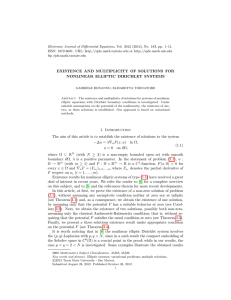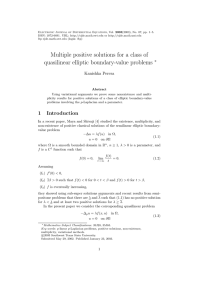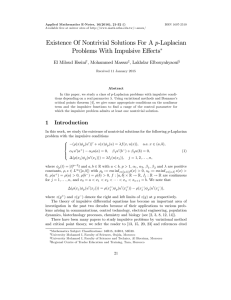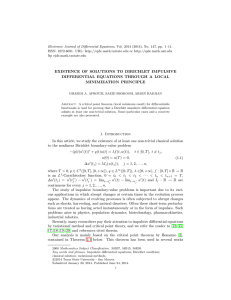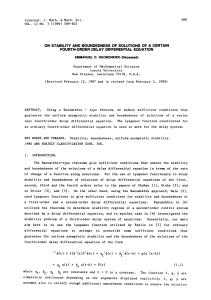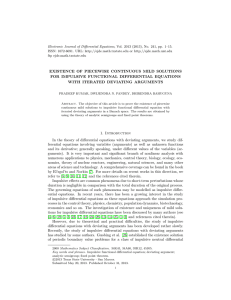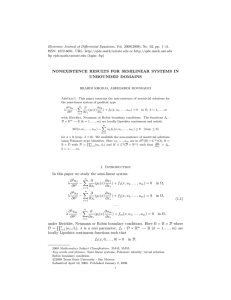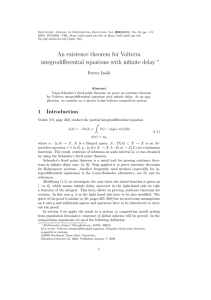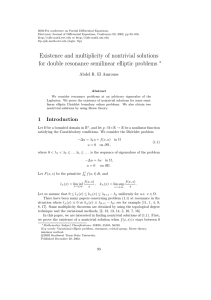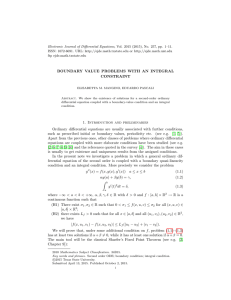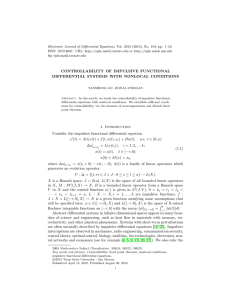Electronic Journal of Differential Equations, Vol. 2013 (2013), No. 126,... ISSN: 1072-6691. URL: or
advertisement
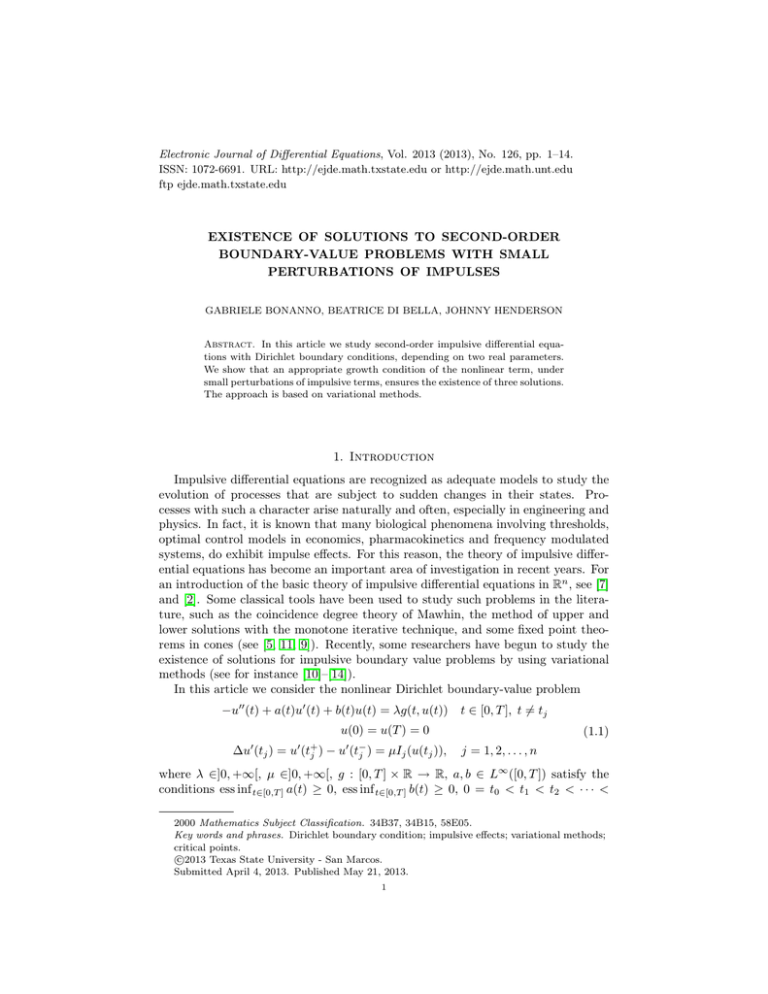
Electronic Journal of Differential Equations, Vol. 2013 (2013), No. 126, pp. 1–14.
ISSN: 1072-6691. URL: http://ejde.math.txstate.edu or http://ejde.math.unt.edu
ftp ejde.math.txstate.edu
EXISTENCE OF SOLUTIONS TO SECOND-ORDER
BOUNDARY-VALUE PROBLEMS WITH SMALL
PERTURBATIONS OF IMPULSES
GABRIELE BONANNO, BEATRICE DI BELLA, JOHNNY HENDERSON
Abstract. In this article we study second-order impulsive differential equations with Dirichlet boundary conditions, depending on two real parameters.
We show that an appropriate growth condition of the nonlinear term, under
small perturbations of impulsive terms, ensures the existence of three solutions.
The approach is based on variational methods.
1. Introduction
Impulsive differential equations are recognized as adequate models to study the
evolution of processes that are subject to sudden changes in their states. Processes with such a character arise naturally and often, especially in engineering and
physics. In fact, it is known that many biological phenomena involving thresholds,
optimal control models in economics, pharmacokinetics and frequency modulated
systems, do exhibit impulse effects. For this reason, the theory of impulsive differential equations has become an important area of investigation in recent years. For
an introduction of the basic theory of impulsive differential equations in Rn , see [7]
and [2]. Some classical tools have been used to study such problems in the literature, such as the coincidence degree theory of Mawhin, the method of upper and
lower solutions with the monotone iterative technique, and some fixed point theorems in cones (see [5, 11, 9]). Recently, some researchers have begun to study the
existence of solutions for impulsive boundary value problems by using variational
methods (see for instance [10]–[14]).
In this article we consider the nonlinear Dirichlet boundary-value problem
−u00 (t) + a(t)u0 (t) + b(t)u(t) = λg(t, u(t)) t ∈ [0, T ], t 6= tj
u(0) = u(T ) = 0
0
0
∆u (tj ) = u
(t+
j )
0
−u
(t−
j )
= µIj (u(tj )),
(1.1)
j = 1, 2, . . . , n
where λ ∈]0, +∞[, µ ∈]0, +∞[, g : [0, T ] × R → R, a, b ∈ L∞ ([0, T ]) satisfy the
conditions ess inf t∈[0,T ] a(t) ≥ 0, ess inf t∈[0,T ] b(t) ≥ 0, 0 = t0 < t1 < t2 < · · · <
2000 Mathematics Subject Classification. 34B37, 34B15, 58E05.
Key words and phrases. Dirichlet boundary condition; impulsive effects; variational methods;
critical points.
c
2013
Texas State University - San Marcos.
Submitted April 4, 2013. Published May 21, 2013.
1
2
G. BONANNO, B. DI BELLA, J. HENDERSON
EJDE-2013/126
0 −
tn < tn+1 = T , ∆u0 (tj ) = u0 (t+
u0 (t) − limt→t− u0 (t), and
j ) − u (tj ) = limt→t+
j
j
Ij : R → R are continuous for every j = 1, 2, . . . , n.
By a classical solution of (1.1), we mean a function
u ∈ w ∈ C([0, T ] : w|[tj ,tj+1 ] ∈ H 2 ([tj , tj+1 ])
that satisfies the equation in (1.1) a.e. on [0, T ] \ {t1 , . . . , tn }, the limits u0 (t+
j ),
0
u0 (t−
),
j
=
1,
.
.
.
,
n,
exist,
satisfy
the
impulsive
conditions
∆u
(t
)
=
µI
(u(t
))m
j
j
j
j
and the boundary condition u(0) = u(T ) = 0. Clearly, if a, b, g are continuous, then
the classical solution u ∈ C 2 ([tj , tj+1 ]), j = 0, 1, . . . , n, and satisfies the equation in
(1.1) for all t ∈ [0, T ] \ {t1 , . . . , tn }.
By using variational methods, we show the existence of three solutions for this
problem. More precisely, by choosing µ in a suitable way and under a growth
condition on the nonlinear term we prove that (1.1) has at least three solutions for
every λ lying in a precise interval. In particular, we obtain two main theorems. In
the first one (Theorem 3.8) we require on the antiderivative of g both a growth more
then quadratic in a suitable interval and a growth less then quadratic at infinity,
and at the same time, on the impulse Ij , an asymptotic condition is required. In
the second one (Theorem 3.9) we establish the existence of at least three positive
solutions uniformly bounded without asymptotic conditions on g and Ij .
As an example, we present a particular case of Theorem 3.9.
Theorem 1.1. Let g : R → R be a nonnegative continuous and non-zero function
such that
lim+
u→0
g(u)
g(u)
= lim
= 0.
u→+∞ u
u
(1.2)
Then, for every
λ>
(12 + T 2 )e2T
d2
inf
R
2T (eT − 1)(e3T /4 − eT /4 ) d>0 d g(x) dx
0
and for every negative continuous function Ij : R → R, j = 1, . . . , n, there exists
δ ∗ > 0 such that, for each µ ∈]0, δ ∗ [, the problem
−u00 (t) + u0 (t) + u(t) = λg(u(t))
t ∈ [0, T ], t 6= tj
u(0) = u(T ) = 0
0
0
∆u (tj ) = u
(t+
j )
−u
0
(t−
j )
= µIj (u(tj )),
(1.3)
j = 1, 2, . . . , n
has at least three non-zero solutions.
We wish to stress that in many papers, as for instance in [16, 17, 8], under
assumptions similar to those of our results, the authors ensure the existence of at
least only one solution for (1.1) and, moreover, do not give an estimate of λ and µ
and an explicit upper bound, uniformly with respect to parameters, of the solutions.
The remainder of the paper is organized as follows. In Section 2, some preliminary results will be given. In Section 3, we will state and prove the main results of
the paper, as well as give some applications to (1.1).
EJDE-2013/126
EXISTENCE OF SOLUTIONS
3
2. Preliminaries
We consider the following problem, which is slightly different form (1.1),
−(p(t)u0 (t))0 + q(t)u(t) = λf (t, u(t))
t ∈ [0, T ], t 6= tj
u(0) = u(T ) = 0
0
0
∆u (tj ) = u
(t+
j )
(2.1)
− u0 (t−
j ) = µIj (u(tj )),
j = 1, 2, . . . , n
where p ∈ C 1 ([0, T ], [0, +∞[), q ∈ L∞ ([0, T ]) with ess inf t∈[0,T ] q(t) ≥ 0.
It is easy to see that the solutions of (2.1) are solutions of (1.1) if
p(t) = e−
Rt
0
a(τ ) dτ
q(t) = b(t)e−
,
Rt
0
a(τ ) dτ
f (t, u) = g(t, u)e−
,
Rt
0
a(τ ) dτ
.
Let us introduce some notation. In the Sobolev space H01 (0, T ), consider the inner
product
Z T
Z T
(u, v) =
p(t)u0 (t)v 0 (t) dt +
q(t)u(t)v(t) dt ,
0
which induces the norm
Z
kuk =
0
T
p(t)(u0 (t))2 dt +
0
Z
T
1/2
q(t)(u(t))2 dt
.
0
Let us recall the Poincarè type inequality
Z
hZ T
i1/2
i1/2
Th T 0 2
≤
u2 (t) dt
(u ) (t) dt
.
π 0
0
Proposition 2.1. Let u ∈ H01 (0, T ). Then
s
1 T
kuk
kuk∞ ≤
2 p∗
(2.2)
(2.3)
where p∗ := mint∈[0,T ] p(t)
Proof. In view of Hölder’s inequality one has
s
√
T 0
1 T
kuk∞ ≤
ku kL2 ([0,T ]) ≤
kuk .
2
2 p∗
Here and in the sequel f : [0, T ] × R → R is an L1 -Carathéodory function,
namely:
(F1) (a) t → f (t, x) is measurable for every x ∈ R;
(b) x → f (t, x) is continuous for almost every t ∈ [0, T ];
(c) for every ρ > 0 there exists a function lρ ∈ L1 ([0, T ]) such that
sup |f (t, x)| ≤ lρ (t)
|x|≤ρ
for almost every t ∈ [0, T ];
4
G. BONANNO, B. DI BELLA, J. HENDERSON
EJDE-2013/126
Definition 2.2. A function u ∈ H01 (0, T ) is said to be a weak solution of (2.1), if
u satisfies
Z T
Z T
0
0
q(t)u(t)v(t)dt
p(t)u (t)v (t) dt +
0
0
Z
T
−λ
f (t, u(t))v(t) dt + µ
0
for any v ∈
n
X
(2.4)
p(tj )Ij (u(tj ))v(tj ) = 0,
j=1
H01 (0, T ).
Lemma 2.3. u ∈ H01 (0, T ) is a weak solution of (2.1) if and only if u is a classical
solution of (2.1).
Proof. Let u ∈ H01 (0, T ) be a weak solution of (2.1). Then (2.4) holds for any
v ∈ H01 (0, T ). Fix j ∈ {0, 1, 2, . . . , n} and let v̄ ∈ H01 (0, T ) such that v̄(t) = 0 for
all t ∈ [0, tj ] ∪ [tj+1 , T ]. Thus by (2.4) we obtain
Z tj+1
Z tj+1
0
0
[−(p(t)u (t)) v̄(t) + q(t)u(t)v̄(t)] dt − λ
f (t, u(t))v̄(t) dt = 0 .
tj
tj
This implies that
−(p(t)u0 (t))0 + q(t)u(t) = λf (t, u(t))
for almost every t ∈ [tj , tj+1 ]. Hence, u ∈ H 2 (tj , tj+1 ) and satisfies the equation
− (pu0 )0 + qu = λf (t, u)
Now multiplying by v ∈
−
n
X
H01 (0, T )
∆u0 (tj )p(tj )v(tj ) +
Z
almost every t ∈ [0, T ] .
(2.5)
and integrating on [0, T ], we obtain that
T
[−(p(t)u0 (t))0 + q(t)u(t) − λf (t, u(t))] v(t) dt = 0 .
0
j=1
Taking again (2.4) into account, we obtain
n
X
∆u0 (tj )p(tj )v(tj ) = µ
j=1
n
X
Ij (u(tj ))p(tj )v(tj ) .
j=1
Hence ∆u0 (tj ) = µIj (u(tj ), for every j = 1, 2, . . . , n, and the impulsive condition
in (2.1) is satisfied.
Now, we define the functionals Φ, Ψ : H01 (0, T ) → R by
Z T
Z u(tj )
n
1
µX
F (t, u(t)) dt −
p(tj )
Ij (x) dx,
Φ(u) = kuk2 Ψ(u) =
2
λ j=1
0
0
(2.6)
Rξ
for each u ∈ H01 (0, T ), where F (t, ξ) = 0 f (t, x) dx for each (t, ξ) ∈ [0, T ] × R.
Using the property of f and the continuity of Ij , j = 1, 2, . . . , n, we have that
Φ, Ψ ∈ C 1 (H01 (0, T ), R) and for any v ∈ H01 (0, T ), we have
Z T
Z T
Φ0 (u)(v) =
p(t)u0 (t)v 0 (t) dt +
q(t)u(t)v(t) dt
0
and
Ψ0 (u)(v) =
Z
n
T
f (t, u(t))v(t) dt −
0
0
µX
p(tj )Ij (u(tj ))v(tj ).
λ j=1
EJDE-2013/126
EXISTENCE OF SOLUTIONS
5
So, arguing in a standard way, it is possible to prove that the critical points of the
functional Eλ,µ (u) := Φ(u) − λΨ(u) are the weak solutions of problem (2.1) and so
they are classical.
We now state two critical point theorems which are the main tools for the proofs
of our results. The following statement comes easily by the results contained in [4]
and in [3].
Theorem 2.4 ([4, Theorem 2.6]). Let X be a reflexive real Banach space; Φ :
X → R be a sequentially weakly lower semicontinuous, coercive and continuously
Gâteaux differentiable functional whose Gâteaux derivative admits a continuous inverse on X ∗ , Ψ : X → R be a sequentially weakly upper semicontinuous, continuously Gâteaux differentiable functional whose Gâteaux derivative is compact, such
that
Φ(0) = Ψ(0) = 0 .
Assume that there exist r > 0 and x̄ ∈ X, with r < Φ(x̄) such that
(i) supΦ(x)≤r Ψ(x) < rΨ(x̄)/Φ(x̄),
(ii) for each λ in
Λr :=
i Φ(x̄)
r
,
h
Ψ(x̄) supΦ(x)≤r Ψ(x)
,
the functional Φ − λΨ is coercive.
Then, for each λ ∈ Λr the functional Φ − λΨ has at least three distinct critical
points in X.
Theorem 2.5 ([3, Theorem 3.2]). Let X be a reflexive real Banach space; Φ :
X → R be a convex, coercive and continuously Gâteaux differentiable functional
whose Gâteaux derivative admits a continuous inverse on X ∗ , Ψ : X → R be a
continuously Gâteaux differentiable functional whose Gâteaux derivative is compact,
such that
inf Φ = Φ(0) = Ψ(0) = 0 .
X
Assume that there exist two positive constants r1 , r2 > 0 and x̄ ∈ X, with 2r1 <
Φ(x̄) < r22 , such that
(j)
supΦ(x)≤r1 Ψ(x)
r1
supΦ(x)≤r2 Ψ(x)
r2
<
(jj)
<
(jjj) for each λ in
Λ∗r1 ,r2 :=
2 Ψ(x̄)
3 Φ(x̄) ,
1 Ψ(x̄)
3 Φ(x̄) ,
i 3 Φ(x̄)
2 Ψ(x̄)
, min
r1
,
r2
h
supΦ(x)≤r1 Ψ(x) 2 supΦ(x)≤r2 Ψ(x)
and for every x1 , x2 ∈ X, which are local minima for the functional Φ−λΨ,
and such that Ψ(x1 ) ≥ 0 and Ψ(x2 ) ≥ 0, one has inf t∈[0,1] Ψ(tx1 + (1 −
t)x2 ) ≥ 0.
Then, for each λ ∈ Λ∗r1 ,r2 the functional Φ − λΨ has at least three distinct critical
points which lie in Φ−1 (] − ∞, r2 [).
6
G. BONANNO, B. DI BELLA, J. HENDERSON
EJDE-2013/126
3. Main results
First, we give the following lemma which we will use in the proof of our main
result.
Lemma 3.1. Assume that
(H1) there exist constants α, β > 0 and σ ∈ [0, 1[ such that
|Ij (x)| ≤ α + β|x|σ
Then, for any u ∈
n
X
H01 (0, T ),
Z
u(tj )
p(tj )
one has
n
X
Ij (x) dx ≤
p(tj ) αkuk∞ +
0
j=1
for all x ∈ R, j = 1, 2, . . . , n .
j=1
Proof. Thanks to condition (H1), one has
Z
u(tj )
Ij (x) dx ≤ α|u(tj )| +
0
β
.
kukσ+1
∞
σ+1
(3.1)
β
|u(tj )|σ+1 .
σ+1
Thus, (3.1) is obtained.
Remark 3.2. It is easy to verify that the condition
(H1’) There exist constants γj , βj > 0 and σj ∈ [0, 1[ , (j = 1, 2, . . . , n), such that
|Ij (x)| ≤ γj + βj |x|σj
for all x ∈ R, j = 1, 2, . . . , n .
is equivalent to (H1). In fact, it is sufficient to put β := max1≤j≤n βj , γ :=
max1≤j≤n γj , α = γ + β and σ := max1≤j≤n σj .
Now, put
p̃ :=
n
X
p(tj ),
k :=
j=1
6p∗
,
12kpk∞ + T 2 kqk∞
Γc :=
β σ−1
α
+
c
,
c
σ+1
where α, β, σ are given by (h1 ) and c is a positive constant.
Theorem 3.3. Suppose that (F1), (H1) are satisfied. Furthermore, assume that
there exist two positive constants c, d, with c < d, such that
(A1) F (t, ξ) ≥ 0 for all (t, ξ) ∈ [0, T4 ] ∪ [ 3T
4 , T ] × [0, d];
(A2)
R 3T /4
RT
F (t, d) dt
max
F
(t,
ξ)
dt
|ξ|≤c
T /4
0
<k
;
2
c
d2
(A3)
RT
supt∈[0,T ] F (t, ξ)
π 2 0 max|ξ|≤c F (t, ξ) dt
lim sup
≤
.
ξ2
4T
c2
|ξ|→+∞
Then, for every λ in
i 2p∗
h
d2
2p∗
c2
Λ :=
,
,
RT
R 3T /4
kT
F (t, d) dt T 0 max|ξ|≤c F (t, ξ) dt
T /4
there exists
n 2p∗ c2 − λT
1
δ :=
min
T p̃
RT
0
max|ξ|≤c F (t, ξ) dt kλT
,
c2 Γ c
R 3T /4
T /4
F (t, d) dt − 2p∗ d2 o
d2 Γ(d/√k)
EJDE-2013/126
EXISTENCE OF SOLUTIONS
7
such that, for each µ ∈ [0, δ[ the problem (2.1) has at least three distinct classical
solutions.
Proof. First, we observe that due to (A2) the interval Λ is non-empty and, consequently, one has δ > 0. Now, fix λ and µ as in the conclusion. Our aim is to
apply Theorem 2.4. For this end, take X = H01 (0, T ) and Φ, Ψ as in (2.6). Put
r = 2c2 p∗ /T . Taking (2.3) into account, for every u ∈ X such that Φ(u) ≤ r, one
has maxt∈[0,T ] |u(t)| ≤ c. Consequently, from Lemma 3.1 it follows that
Z T
µ β σ+1 sup Ψ(u) ≤
max F (t, ξ) dt + p̃ αc +
c
;
λ
σ+1
Φ(u)≤r
0 |ξ|≤c
that is,
RT
i
supΦ(u)≤r Ψ(u)
T h 0 max|ξ|≤c F (t, ξ) dt µ
≤ ∗
+
p̃Γ
.
c
r
2p
c2
λ
Hence, bearing in mind that µ < δ, one has
supΦ(u)≤r Ψ(u)
1
< .
r
λ
(3.2)
Put
4d
t ∈ [0, T /4],
T t,
v̄(t) = d,
t ∈]T /4, 3T /4],
4d
T (T − t), t ∈]3T /4, T ].
Clearly v̄ ∈ X. Moreover, one has
So, from c <
we have
√
2d2 (12kpk∞ + T 2 kqk∞ )
4d2 p∗
8p∗ 2
d ≤ kv̄k2 ≤
=
.
T
3T
kT
(3.3)
2d we obtain r < Φ(v̄). Moreover, again from the previous inequality,
2p∗ d2
.
kT
Now, due to Lemma 3.1, (A1), (2.3) and (3.3) one has
Z 3T /4
µ β
Ψ(v̄) ≥
F (t, d) dt − p̃ αkv̄k∞ +
kv̄kσ+1
∞
λ
σ+1
T /4
Z 3T /4
µ p̃ d2
Γ √ .
≥
F (t, d) dt −
λ k (d/ k)
T /4
Φ(v̄) <
So, we obtain
kT
Ψ(v̄)
≥
Φ(v̄)
Since µ < δ, one has
R 3T /4
T /4
F (t, d) dt − µλ p̃T d2 Γ(d/√k)
2p∗ d2
.
1
Ψ(v̄)
> .
(3.4)
Φ(v̄)
λ
Therefore, from (3.2) and (3.4), condition (i) of Theorem 2.4 is fulfilled.
Now, to prove the coercivity of the functional Φ − λΨ, due to (A3), we have
supt∈[0,T ] F (t, ξ)
π 2 p∗ 1
<
.
ξ2
2T 2 λ
|ξ|→+∞
lim sup
8
G. BONANNO, B. DI BELLA, J. HENDERSON
EJDE-2013/126
So, we can fix ε > 0 satisfying
supt∈[0,T ] F (t, ξ)
π 2 p∗ 1
<
ε
<
.
ξ2
2T 2 λ
|ξ|→+∞
lim sup
Then, there exists a positive constant h such that
F (t, ξ) ≤ ε|ξ|2 + h ∀t ∈ [0, T ], ∀ξ ∈ R .
Taking into account Lemma 3.1, Proposition 2.1 and (2.2), it follows that
Φ(u) − λΨ(u)
s
s
i
h 1 T
1
β 1 T σ+1
2
2
≥ kuk − λεkukL2 [0,T ] − λhT − µp̃ α
kuk +
kukσ+1
∗
∗
2
2 p
σ+1 2 p
s
s
1
h 1 T
1 T σ+1
i
T2 β
σ+1
≥
− λε 2 ∗ kuk2 − λhT − µp̃ α
kuk
+
kuk
,
2
π p
2 p∗
σ + 1 2 p∗
for all u ∈ H01 (0, T ). So, the functional Φ − λΨ is coercive. Now, the conclusion of
Theorem 2.4 can be used. It follows that, for every
i 2k
h
d2
c2
2
λ∈
, R1
,
R 3T /4
T
T
max
F
(t,
ξ)
dt
F
(t,
d)
dt
|ξ|≤c
0
T /4
the functional Φ − λΨ has at least three distinct critical points in X, which are the
weak solutions of the problem (2.1). This completes the proof.
Corollary 3.4. Suppose that (H1) holds. Let h ∈ L1 ([0, T ]) be a nonnegative
and non-zero function and let g : R → R be a continuous function. Put h0 :=
R 3T /4
Rξ
h(t)dt and G(ξ) = 0 g(x)dx for all ξ ∈ R, and assume that there exist two
T /4
positive constants c, d, with c < d, such that
(A1’) G(ξ) ≥ 0 for all ξ ∈ [0, d];
(A2’)
max|ξ|≤c G(ξ)
1 h0 G(d)
<
;
2
c
2 khk1 d2
(A3’) lim sup|ξ|→+∞ G(ξ)/ξ 2 ≤ 0.
Then, for every λ in
Λ :=
i 4 d2
h
2
c2
,
,
T h0 G(d) T khk1 max|ξ|≤c G(ξ)
there exists
δ :=
n 2c2 − λT khk max
1
1
|ξ|≤c G(ξ)
min
,
Tn
c2 Γc
λT h0
2o
2 G(d) − 2d
d2 Γ(√2d)
such that, for each µ ∈ [0, δ[ the problem
−u00 (t) = λh(t)g(u(t))
t ∈ [0, T ], t 6= tj
u(0) = u(T ) = 0
0
0
∆u (tj ) = u
(t+
j )
0
−u
(t−
j )
has at least three classical solutions.
= µIj (u(tj )),
(3.5)
j = 1, 2, . . . , n
EJDE-2013/126
EXISTENCE OF SOLUTIONS
9
The proof of the above corollary follows from Theorem 3.3 by choosing f (t, x) =
h(t)g(x) for all (t, x) ∈ [0, T ] × R and taking into account that k = 1/2.
Remark 3.5. Clearly, if g is nonnegative then assumption (A1’) is verified and
(A2’) becomes
G(c)
1 h0 G(d)
<
.
c2
2 khk1 d2
Now, we state a result without asymptotic conditions on Ij . The following lemma
will be crucial in our arguments.
Lemma 3.6. Suppose that (F1) is satisfied. Moreover, assume that f (t, x) ≥ 0 for
all (t, x) ∈ [0, T ] × R and Ij (x) ≤ 0 for all x ∈ R, j = 1, . . . , n. If u is a classical
solution of (2.1), then u(t) ≥ 0 for all t ∈ [0, T ].
Proof. If u is a classical solution of(2.1), then
Z T
Z T
Z
(p(t)u0 (t))0 v(t) dt −
q(t)u(t)v(t) dt + λ
0
0
T
f (t, u(t))v(t) dt = 0
0
for all v ∈ X. Let v(t) = max{−u(t), 0} for all t ∈ [0, T ]; clearly v ∈ X and we
have
Z T
Z T
n Z tj+1
X
0
0
0=
(p(t)u (t)) v(t) dt −
q(t)u(t)v(t) dt + λ
f (t, u(t))v(t) dt
=
j=0
n
X
tj
0
tj+1
p(t)u0 (t)v(t)t −
j
j=0
Z
0
T
p(t)u0 (t)v 0 (t) dt −
0
Z
T
q(t)u(t)v(t) dt
0
T
Z
+λ
f (t, u(t))v(t) dt
0
=−
n
X
∆u0 (tj )p(tj )v(tj ) −
T
Z
q(t)u(t)v(t) dt
0
T
+λ
= −µ
p(t)u0 (t)v 0 (t) dt −
0
j=1
Z
T
Z
f (t, u(t))v(t) dt
0
n
X
Z
Ij (u(tj ))p(tj )v(tj ) +
+λ
p(t)(v 0 (t))2 dt +
0
j=1
Z
T
Z
T
q(t)(v(t))2 dt
0
T
f (t, u(t))v(t) dt
0
≥ kvk2 .
So v(t) = 0 for t ∈ [0, T ].
Put
=c :=
n
X
j=1
Z
min
|ξ|≤c
ξ
Ij (x) dx,
for all c > 0 .
0
Our other main result is as follows.
Theorem 3.7. Suppose that (F1) is satisfied. Furthermore,
assume that there exist
q
k
three positive constants c1 , c2 , d, with c1 < d < 2 c2 , such that
10
G. BONANNO, B. DI BELLA, J. HENDERSON
EJDE-2013/126
(B1) f (t, ξ) ≥ 0 for all (t, ξ) ∈ [0, T ] × [0, c2 ];
(B2)
R 3T /4
RT
F (t, c1 ) dt
2 T /4 F (t, d) dt
0
< k
;
c21
3
d2
(B3)
RT
0
F (t, c2 ) dt
k
<
c22
3
R 3T /4
T /4
F (t, d) dt
d2
.
Let
Λ0 :=
i 3p∗
kT
n
oh
2c21
p∗
c22
min R T
.
, RT
F (t, c1 ) dt 0 F (t, c2 ) dt
F (t, d) dt T
0
d2
R 3T /4
T /4
,
Then, for every λ ∈ Λ0 and for every negative continuous function Ij , j = 1, . . . , n,
there exists
n λT R T F (t, c ) dt − 2p∗ c2 λT R T F (t, c ) dt − p∗ c2 o
1
1
2
1
2
0
0
δ ∗ :=
min
,
T kpk∞
=c 1
=c 2
such that, for each µ ∈]0, δ ∗ [ the problem (2.1) has at least three classical solutions
ui , i = 1, 2, 3, such that 0 < kui k∞ ≤ c2 .
Proof. Without loss of generality, we can assume f (t, x) ≥ 0 for all (t, x) ∈ [0, T ]×R.
Fix λ, Ij and µ as in the conclusion and take X, Φ and Ψ as in the proof of Theorem
2p∗ c2
2p∗ c2
3.3. Put v̄ as in Theorem 3.3, r1 = T 1 and r2 = T 2 . Therefore, one has
2r1 < Φ(v̄) < r22 and since µ < δ ∗ , one has
Z
1
T T
µ
sup Ψ(u) ≤ ∗ 2
F (t, c1 ) dt − kpk∞ =c1
r1 Φ(u)<r1
2p c1 0
λ
R 3T /4
T T /4 F (t, d) dt
1
< <
λ
3k
d2
2 Ψ(v̄)
≤
,
3 Φ(v̄)
and
2
r2
T sup Ψ(u) ≤ ∗ 2
p c2
Φ(u)<r2
T
Z
F (t, c2 ) dt −
0
1
T
< <
λ
3k
2 Ψ(v̄)
≤
.
3 Φ(v̄)
R 3T /4
T /4
µ
kpk∞ =c2
λ
F (t, d) dt
d2
Therefore, conditions (j) and (jj) of Theorem 2.5 are satisfied. Finally, let u1 and u2
be two local minima for Φ−λΨ. Then, u1 and u2 are critical points for Φ−λΨ, and
so, they are weak solutions for the problem (2.1). Hence, owing to Lemma 3.6, we
obtain u1 (t) ≥ 0 and u2 (t) ≥ 0 for all t ∈ [0, T ]. So, one has Ψ(su1 + (1 − s)u2 ) ≥ 0
for all s ∈ [0, 1]. From Theorem 2.5 the functional Φ−λΨ has at least three distinct
critical points which are weak solutions of (2.1). This complete the proof.
EJDE-2013/126
EXISTENCE OF SOLUTIONS
11
Let A(t) a primitive of a(t), g : [0, T ] × R → R an L1 -Carathéodory function and
put
Z ξ
6e−A(T )
G(t, ξ) =
g(t, x) dx, k̃ :=
.
12 + T 2 kbe−A k∞
0
By Theorems 3.3 and 3.7, we obtain the following results for problem (1.1).
Theorem 3.8. Suppose that (H1) holds. Furthermore, assume that there exist two
positive constants c, d, with c < d, such that
(I1) G(t, ξ) ≥ 0 for all (t, ξ) ∈ [0, T4 ] ∪ [ 3T
4 , T ] × [0, d];
(I2)
R 3T /4 −A(t)
R T −A(t)
e
G(t, d) dt
e
max
G(t,
ξ)
dt
T /4
|ξ|≤c
0
< k̃
;
2
2
c
d
(I3) lim sup|ξ|→+∞
supt∈[0,T ] e−A(t) G(t,ξ)
ξ2
≤
π2
4T
RT
0
e−A(t) max|ξ|≤c G(t,ξ) dt
.
c2
Let
Λ :=
i
h
c2
2
d2
2
,
.
R
R
T
k̃T ekak1 3T /4 e−A(t) G(t, d) dt T ekak1 0 e−A(t) max|ξ|≤c G(t, ξ) dt
T /4
Then, for every λ ∈ Λ, there exists
n 2c2 e−kak1 − λT R T e−A(t) max
1
|ξ|≤c G(t, ξ) dt
0
min
δ :=
,
2
ẽT
c Γc
R 3T /4
k̃λT T /4 e−A(t) G(t, d) dt − 2e−kak1 d2 o
d2 Γ(d/√k)
such that, for each µ ∈ [0, δ[ the problem (1.1) has at least three distinct classical
solutions.
The above theorem follows immediately from Theorem 3.3 taking into account
Section 2.
Theorem
3.9. Assume that there exist three positive constants c1 , c2 , d, with c1 <
q
k̃
d < 2 c2 , such that
(J1) g(t, ξ) ≥ 0 for all (t, ξ) ∈ [0, T ] × [0, c2 ];
(J2)
R 3T /4 −A(t)
R T −A(t)
e
G(t, d) dt
e
G(t,
c
)
dt
2
1
T /4
0
<
k̃
;
c21
3
d2
(J3)
R 3T /4 −A(t)
R T −A(t)
G(t, d) dt
e
G(t, c2 ) dt
k̃ T /4 e
0
<
.
2
2
c2
3
d
Then, for every λ in
i 3e−kak1
d2
Λ0 :=
,
R 3T /4
k̃T
e−A(t) G((t, d) dt
T /4
n
oh
e−kak1
2c21
c22
min R T
, RT
,
T
e−A(t) G(t, c1 ) dt 0 e−A(t) G(t, c2 ) dt
0
12
G. BONANNO, B. DI BELLA, J. HENDERSON
EJDE-2013/126
and for every negative continuous function Ij , j = 1, . . . , n, there exists
n λT R T e−A(t) G(t, c ) dt − 2e−kak1 c2
1
1
1
∗
0
δ := min
,
T
=c1
R T −A(t)
λT
e
G(t, c ) dt − e−kak1 c2 o
2
0
2
=c 2
such that, for each µ ∈]0, δ ∗ [, problem (1.1) has at least three classical solutions ui ,
i = 1, 2, 3, such that 0 < kui k∞ ≤ c2 .
The above theorem follows from Theorem 3.7 when taking into account Section
2.
We want to point out that the function a(t) can be taken of any sign, provided
changes are made to the constant k̃. When g : R → R is a nonnegative continuous
function, the assumptions in Theorem 3.9 take a simpler form:
Theorem 3.10. Put
R 3T /4
θ :=
T /4
e−A(t) dt
ke−A k1
,
k ∗ :=
2
k̃θ,
3
L :=
e−kak1
.
T ke−A k1
Assume that there exist three positive constants c1 , c2 , d, with c1 < d <
such that
(J2”) G(c1 )/c21 < k ∗ G(d)/d2 ;
∗
(J3”) G(c2 )/c22 < k2 G(d)/d2 .
Then, for every λ in
i 2L d2
2c21
c22 h
,
L
min
,
,
Λ00 :=
k ∗ G(d)
G(c1 ) G(c2 )
1
2
q
3k∗
θ c2 ,
and for every negative continuous function Ij , j = 1, . . . , n, there exists
n λG(c ) − 2Lc2 λG(c ) − Lc2 o
1
2
1
2
δ ∗ := ke−A k1 min
,
=c 1
=c 2
such that, for each µ ∈]0, δ ∗ [, problem (1.1) has at least three classical solutions ui ,
i = 1, 2, 3, such that 0 < kui k∞ ≤ c2 .
Now using Theorem 3.10, we give the proof of Theorem 1.1.
Rξ
Proof of Theorem 1.1. Fix λ > λ1 , put G(ξ) = 0 g(x) dx for all ξ ∈ R, and let
d > 0 such that G(d) > 0 and
λ>
(12 + T 2 )e2T
d2
.
2T (eT − 1)(e3T /4 − eT /4 ) G(d)
From (1.2) there is c1 > 0 such that c1 < d and G(c1 )/c21 < 2/(T (eT − 1)λ), and
there is c2 > 0 such that
s
3e−T
G(c2 )
1
d<
c2 ,
<
.
12 + T 2
c22
T (eT − 1)λ
Therefore, Theorem 3.10 ensures the conclusion.
Finally, we give two applications of the results above.
EJDE-2013/126
EXISTENCE OF SOLUTIONS
Example 3.11. The problem
t
−u00 (t) + ( − 1)2 u(t) = λu2 (3 − 4u) sin t a.e. in [0, π]
π
u(0) = u(π) = 0
p
3
0
0 +
u(t1 ))
∆u (t1 ) = u (t1 ) − u0 (t−
1 ) = µ(1 −
13
(3.6)
admits at least three non-trivial solutions for each λ ∈ [7, 20] and for each 0 < µ <
1
63λπ
38π (1 − 4096 ).
Indeed, it is sufficient to apply Theorem 3.3 by choosing, for instance, c = 1/64
and d = 1/2.
We remark that although [17, Theorem 3.2] can be applied, it guarantees the
existence of at least one solution, only. Our results go further than [1, Theorem 1],
we have precise values of the parameter λ for which the problem admits solutions.
Example 3.12. Let g : (t, x) ∈ (0, 1] × R → R, be defined as
√
−2
−4 t2 4
10 e √/ t if x ≤ 10
2
4
−2
2
t
g(t, x) = x e / t
if 10 < x ≤ 1
√
t2
2 4
e /(x t) if x > 1.
By Theorem 3.9, for each λ ∈ [33, 55] and each µ ∈]0, 3.4 × 10−4 [ the problem
−u00 (t) + 2tu0 (t) + (1 − t)u(t) = λg(t, u(t))
a.e. in [0, 1]
u(0) = u(1) = 0
0
0
∆u (t1 ) = u
(t+
1)
3
− u0 (t−
1 ) = µ(−1 − |u(t1 )| )
admits at least three non-trivial solutions ui , such that 0 < |ui (t)| < 102 for all
t ∈ [0, 1], i = 1, 2, 3.
It suffices to choose, for instance, c1 = 10−2 , c2 = 102 , d = 1.
We observe that in Example 3.11 we do not have the negativity of the impulsive
term, so we cannot apply Theorem 3.9. On the other hand, in Example 3.12 the
function is negative, but it does not have the sublinear growth.
References
[1] Bai, L.; Dai, B.; An application of variational methods to a class of Dirichlet boundary value
problems with impulsive effects, J. Franklin Inst. 348 (2011), 2607–2624.
[2] Benchohra, M.; Henderson, J.; Ntouyas, S.; Theory of Impulsive Differential Equations,
Contemporary Mathematics and Its Applications, 2. Hindawi Publishing Corporation, New
York, (2006).
[3] Bonanno G. and Candito P., Non-differentiable functionals and applications to elliptic problems with discontinuous nonlinearities, J. Differential Equations, 244 (2008), 3031–3059.
[4] Bonanno, G.; Marano, S.A.; On the structure of the critical set of non-differentiable functionals with a weak compactness condition, Appl. Anal., 89 (2010), 1–10.
[5] Chen, J.; Tisdell, C.C.; Yuan, R.; On the solvability of periodic boundary value problems with
impulse, J. Math. Anal. Appl., 331 (2007), 902–912.
[6] Chen, P.; Tang, X. H.; New existence and multiplicity of solutions for some Dirichlet problems
with impulsive effects, Math. Comput. Modelling, 55 (2012), 723–739.
[7] Lakshmikantham, V.; Bainov, D. D.; Simeonov, P.S.; Impulsive differential equations and
inclusions, World Scientific, Singapore (1989).
[8] Liu, Z.; Chen, H.; Zhou, T.; Variational methods to the second-order impulsive differential
equation with Dirichlet boundary value problem, Comput. Math. Appl., 61 (2011), 1687–1699.
14
G. BONANNO, B. DI BELLA, J. HENDERSON
EJDE-2013/126
[9] Mawhin, J.; Topological degree and boundary value problems for nonlinear differential equations, Topological methods for ordinary differential equations, Lecture Notes in Math., 1537
Springer, Berlin, 1993, 74-142.
[10] Nieto, J. J.; O’Regan, D.; Variational approach to impulsive differential equations, Nonlinear
Anal., RWA,70 (2009), 680–690.
[11] Qian, D.; Li, X.; Periodic solutions for ordinary differential equations with sublinear impulsive effects, J. Math. Anal. Appl., 303 (2005), 288–303.
[12] Tian, Y.; Ge, W. G.; Applications of variational methods to boundary value problem for
impulsive differential equations, Proc. Edinburgh Math. Soc., 51 (2008), 509–527.
[13] Wang, W.; Shen, J.; Eigenvalue problems of second order impulsive differential equations,
Comput. Math. Appl., 62 (2011), 142-150.
[14] Wang, W.; Yang, X.; Multiple solutions of boundary-value problems for impulsive differential
equations, Math. Meth. Appl. Sci., 34 (2011), 1649-1657.
[15] Xiao, J.; Nieto, J. J.; Variational approach to some damped Dirichlet nonlinear impulsive
differential equations, Journal of the Franklin Institute, 348 (2011), 369-377.
[16] Zhang, D.; Dai, B.; Existence of solutions for nonlinear impulsive differential equations with
Dirichlet boundary conditions, Math. Comput. Modelling, 53 (2011), 1154–1161.
[17] Zhou, J.; Li, Y.; Existence and multiplicity of solutions for some Dirichlet problems with
impulse effects, Nonlinear Anal., TMA,71 (2009), 2856–2865.
Gabriele Bonanno
Department of Civil, Information Technology, Construction, Environmental Engineering and Applied Mathematics, University of Messina, 98166 - Messina, Italy
E-mail address: bonanno@unime.it
Beatrice Di Bella
Department of Mathematics and Computer Science, University of Messina, 98166 Messina, Italy
E-mail address: bdibella@unime.it
Johnny Henderson
Department of Mathematics, Baylor University, Waco, TX 76798-7328, USA
E-mail address: Johnny Henderson@baylor.edu
